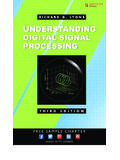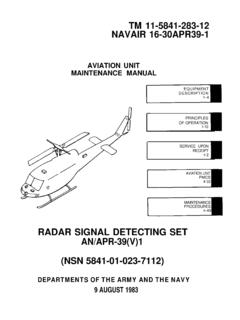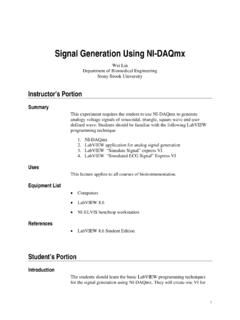Transcription of SIGNALPROCESSING FORCOMMUNICATIONS
1 signal processing for Communications, by and M. Vetterli, 2008, EPFL PressSIGNAL PROCESSINGFOR COMMUNICATIONSS ignal processing for Communications, by and M. Vetterli, 2008, EPFL PressAboutthecoverphotographAutumn leaves in the Gorges de l Areuse, being a beautiful picture, this photograph also illustrates a basic signal processing concept. Theexposuretimeisontheorderof asecond,ascanbeseenfromthefuzzinessof theswirlingleaves;inotherwords,the photograph is the average,over a one-second interval,of the light intensity and of the color ,thelightonthecamera'sfilmisathree-dimen sionalprocess, with two spatial dimensions (the focal plane) and one time dimension.
2 By taking a photographwearesamplingthisprocessatapar ticulartime,whileatthesametimeintegratin g( )the process over the exposure interval (which can range from a fraction of a second to several seconds). signal processing for Communications, by and M. Vetterli, 2008, EPFL PressEPFL PressA Swiss academic publisher distributed by CRC PressCommunicationandInformationSciences signal PROCESSINGFOR COMMUNICATIONSP aolo Prandoni and MartinVetterliSignal processing for Communications, by and M. Vetterli, 2008, EPFL Pressis an imprint owned by Presses polytechniques et universitaires romandes, aSwiss academic publishing company whose main purpose is to publish theteaching and research works of the Ecole polytechnique f d rale de polytechniques et universitaires romandesEPFL Centre MidiPost office box 119CH-1015 21 30 Fax.
3 021/693 40 2008,First edition,EPFL PressISBN 978-2-940222-20-9 (EPFL Press)ISBN 978-1-4200-7046-0 (CRC Press)Printed in ItalyAll right reserved (including those of translation into other languages). No partof this book may be reproduced in any form by photoprint, microfilm, or anyother means nor transmitted or translated into a machine language withoutwritten permission from the ,LLC6000 Broken Sound Parkway,NW,Suite 300,Boca Raton,FL of Congress Cataloging-in-Publication DataA catalog record for this book is available from the Library of photograph credit.
4 Autumn leaves in the Gorges de l Areuse, AdrienVetterli,all rights book is published under the editorial direction of Professor SergeVaudenay(EPFL).The authors and publisher express their thanks to the Ecole polytechnique f d ralede Lausanne (EPFL) for its generous support towards the publication of this processing for Communications, by and M. Vetterli, 2008, EPFL PressTo wine, women and PrandoniTo my children, Thomas and No mie, who might one day learn fromthis book the magical inner-workings of their mp3 player, mobile phone andother objects of the digital processing for Communications, by and M.
5 Vetterli, 2008, EPFL PressSignal processing for Communications, by and M. Vetterli, 2008, EPFL PressPrefaceThe present text evolved from course notes developed over a period of adozen years teaching undergraduates the basics of signal processing FORCOMMUNICATIONS . The students had mostly a background in electrical engi-neering, computer science or mathematics, and were typically in their thirdyear of studies at Ecole Polytechnique F d rale de Lausanne (EPFL), with aninterest in communication systems. Thus, they had been exposed to signalsand systems, linear algebra, elements of analysis ( Fourier series) andsome complex analysis, all of this being fairly standard in an undergraduateprogram in engineering notes having reached a certain maturity, including examples, solvedproblems and exercises, we decided to turn them into an easy-to-use text onsignal processing , with a look at communications as an application.
6 Butrather than writing one more book on signal processing , of which manygood ones already exist, we deployed the following variations, which wethink will make the book appealing as an undergraduate Less formal: Both authors came to signal processing by way of an in-terest in music and think that signal processing is fun, and should betaught to be fun! Thus, choosing between the intricacies ofz-trans-form inversion through contour integration (how many of us haveever done this after having taken a class in signal processing ?)
7 Orshowing the Karplus-Strong algorithm for synthesizing guitar sounds(which also intuitively illustrates issues of stability along the way), youcan guess where our choice mathematical rigor is not the emphasis, we made sure to beprecise, and thus the text is not approximate in its use of mathemat-ics. Remember, we think signal processing to be mathematics appliedto a fun topic, and not mathematics for its own sake, nor a set of ap-plications without processing for Communications, by and M. Vetterli, 2008, EPFL PressviiiPreface2.
8 More conceptual: We could have said more abstract , but this soundsscary (and may seem in contradiction with point 1 above, which ofcourse it is not). Thus, the level of mathematical abstraction is prob-ably higher than in several other texts on signal processing , but it al-lows to think at a higher conceptual level, and also to build founda-tions for more advanced topics. Therefore we introduce vector spaces,Hilbert spaces, signals as vectors, orthonormal bases, projection the-orem, to name a few, which are powerful concepts not usually em-phasized in standard texts.
9 Because these are geometrical concepts,they foster understanding without making the text any more , this constitutes the foundation of modern signal processing ,techniques such as time-frequency analysis, filter banks and wavelets,which makes the present text an easy primer for more advanced sig-nal processing books. Of course, we must admit, for the sake of fulltransparency, that we have been influenced by our research work, butagain, this has been fun too!3. More application driven: This is an engineering text, which shouldhelp the student solve real problems.
10 Both authors are engineers bytraining and by trade, and while we love mathematics, we like to seetheir operational value . That is, does the result make a difference inan engineering application?Certainly, the masterpiece in this regard is C. Shannon s 1948 foun-dational paper on The Mathematical Theory of communication . Itcompletely revolutionized the way communication systems are de-signed and built, and, still today, we mostly live in its legacy. Notsurprisingly, one of the key results of signal processing is the sam-pling theorem for bandlimited functions (often attributed to Shan-non, since it appears in the above-mentioned paper), the theoremwhich single-handedly enabled the digital revolution.









